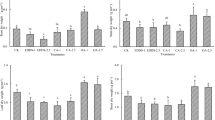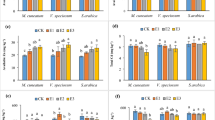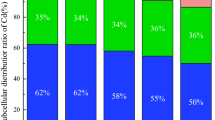Abstract
Athyrium wardii (Hook.) is a promising herbaceous plant species for phytostabilization of cadmium (Cd)-contaminated sites with large biomass and fast growth rate. However, little information is available on its tolerance mechanisms toward Cd. To further understand the mechanisms involved in Cd migration, accumulation and detoxification, the present study investigated subcellular distribution and chemical forms of Cd in the mining ecotypes and corresponding non-mining ecotypes of A. wardii via greenhouse pot experiment. Subcellular fractionation of Cd-containing tissues demonstrated that the majority of the element was mainly located in soluble fraction in cell walls. This indicated that both the vacuoles and cell walls might be evolved the Cd tolerance mechanisms to protect metabolically active cellular compartments from toxic Cd concentrations. Meanwhile, Cd taken up by the plant existed in different chemical forms. Results showed that the majority of Cd in plant was in undissolved Cd–phosphate complexes (extracted by 2 % CH3COOH), followed by water-soluble Cd–organic acid complexes, Cd(H2PO4)2, pectates and protein form (extracted by deionized water and 1 M NaCl), whereas only small amount of Cd in roots was in inorganic form (extracted by 80 % ethanol), which suggests low capacity to be transported to aboveground tissues. It could be suggested that Cd integrated with undissolved Cd–phosphate complexes in cell wall or compartmentalization in vacuole might be responsible for the adaptation of the mining ecotypes of A. wardii to Cd stress.




Similar content being viewed by others
References
Ashraf MA, Maah MJ, Yusoff I (2011) Heavy metals accumulation in plants growing in ex tin mining catchment. Int J Environ Sci Tech 8(2):401–416
Baker AJM (1984) Environmentally-induced cadmium tolerance in the grass Holcus lanatus L. Chemosphere 13(4):585–589
Bhatia NP, Walsh KB, Baker AJM (2005) Detection and quantification of ligands involved in nickel detoxification in a herbaceous Ni hyperaccumulator Stackhousia tryonii Bailey. J Exp Bot 56(415):1343–1349
Cataldo DA, Garland TR, Wildung RE (1981) Cadmium distribution and chemical fate in soybean plants. Plant Physiol 68:835–839
Clemens S (2001) Molecular mechanisms of plant metal tolerance and homeostasis. Planta 212(4):475–486
Dede G, Ozdemir S, Dede OH (2012) Effect of soil amendments on phytoextraction potential of Brassica juncea growing on sewage sludge. Int J Environ Sci Tech 9(3):559–564
Domínguez MT, Madrid F, Marañón T, Murillo JM (2009) Cadmium availability in soil and retention in oak roots: potential for phytostabilization. Chemosphere 76(4):480–486
Feng XD, Dang Z, Huang WL, Yang C (2009) Chemical speciation of fine particle bound trace metals. Int J Environ Sci Tech 6(3):337–346
Fu X, Dou C, Chen Y, Chen X, Shi J, Yu M, Xu J (2011) Subcellular distribution and chemical forms of cadmium in Phytolacca americana L. J Hazard Mater 186(1):103–107
Guo SX, Han TT, Liu RJ (2011) Effects of arbuscular mycorrhizal (AM) fungi Glomus mosseae on characteristics of leaf development of Paeonia suffruticosa under salt stress. Afr J Microbiol Res 5(6):714–719
Gussarsson M (1994) Cadmium-induced alterations in nutrient composition and growth of Betula pendula seedlings: the significance of fine roots as a primary target for cadmium toxicity. J Plant Nutr 17(2):2151–2163
Hall JL (2002) Cellular mechanisms for heavy metal detoxification and tolerance. J Exp Bot 53(366):1–11
Harada E, Yamaguchi Y, Koizumi N, Hiroshi S (2002) Cadmium stress induces production of thiol compounds and transcripts for enzymes involved in sulfur assimilation pathways in Arabidopsis. J Plant Physiol 159(4):445–448
He JY, Zhu C, Ren YF, Yan YP, Cheng C, Jiang DA, Sun ZX (2008) Uptake, subcellular distribution, and chemical forms of cadmium in wild-type and mutant rice. Pedosphere 18(3):371–377
Krämer U, Pickering IJ, Prince RC, Raskin I, Salt DE (2000) Subcellular localization and speciation of nickel in hyperaccumulator and non-accumulator Thlaspi species. Plant Physiol 122(4):1343–1354
Ling T, Jun R, Fangke Y (2011) Effect of cadmium supply levels to cadmium accumulation by Salix. Int J Environ Sci Tech 8(3):493–500
Mahvi AH, Gholami F, Nazmara S (2008) Cadmium biosorption from wastewater by Ulmus leaves and their ash. Eur J Sci Res 23(2):197–203
Ramos I, Esteban E, Lucena JJ, Gárate A (2002) Cadmium uptake and subcellular distribution in plants of Lactuca sp. Cd-Mn interaction. Plant Sci 162(5):761–767
Sanità di Toppi L, Gabbrielli R (1999) Response to cadmium in higher plants. Environ Exp Bot 41(2):105–130
Szkoda J, Żmudzki J (2005) Determination of lead and cadmium in biological material by graphite furnace atomic absorption spectrometry method. Bull Vet Inst Pulawy 49:89–92
Vázquez MD, Poschenrieder CH, Barceló J (1992) Ultrastructural effects and localization of low cadmium concentrations in bean roots. New Phytol 120(2):215–226
Verbruggen N, Hermans C, Schat H (2009) Mechanisms to cope with arsenic or cadmium excess in plants. Curr Opin Plant Biol 12(3):364–372
Vig K, Megharaj M, Sethunathan N, Naidu R (2003) Bioavailability and toxicity of cadmium to microorganisms and their activities in soil: a review. Adv Environ Res 8(1):121–135
Wang X, Liu Y, Zeng G, Chai L, Song X, Min Z, Xiao X (2008) Subcellular distribution and chemical forms of cadmium in Bechmeria nivea (L.) Gaud. Environ Exp Bot 62(3):389–395
Weigel HJ, Jäger HJ (1980) Subcellular distribution and chemical form of cadmium in bean plants. Plant Physiol 65:480–482
Wu FB, Dong J, Qian QQ, Zhang GP (2005) Subcellular distribution and chemical form of Cd and Cd-Zn interaction in different barley genotypes. Chemosphere 60(10):1437–1446
Wu Q, Lu YF, Shi JZ, Liang SX, Shi JS, Liu J (2011) Chemical form of metals in traditional medicines underlines potential toxicity in cell cultures. J Ethnopharmacol 134(3):839–843
Xiao G, Li T, Zhang X, Yu H, Huang H, Gupta DK (2009) Uptake and accumulation of phosphorus by dominant plant species growing in a phosphorus mining area. J Hazard Mater 171(1–3):542–550
Xu QS, Min HL, Cai SJ, Fu YY, Sha S, Xie KB, Du KH (2012) Subcellular distribution and toxicity of cadmium in Potamogeton crispus L. Chemosphere 89(1):114–120
Yang JR, He JQ, Zhang GX, Mao XQ (1995) Tolerance mechanism of crops to Cd pollution. Chinese J Appl Ecol 6(1):87–91 (in Chinese)
Zhang X, Zhang S, Xu X, Li T, Gong G, Jia Y, Li Y, Deng L (2010) Tolerance and accumulation characteristics of cadmium in Amaranthus hybridus L. J Hazard Mater 180(1–3):303–308
Zhang SJ, Li TX, Huang HG, Zou TJ, Zhang XZ, Yu HY, Zheng ZC, Wang YD (2012) Cd accumulation and phytostabilization potential of dominant plants surrounding mining tailings. Environ Sci Pollut Res 19(9):3879–3888
Zhou SB, Xu LS, Wu LH, Luo YM, Li N, Cui LQ (2008) Subcellular distribution and chemical forms of Cd and Zn in Sedum jinianum. Chinese J Appl Ecol 19(11):2515–2520 (in Chinese)
Zou T, Li T, Zhang X, Yu H, Luo H (2011) Lead accumulation and tolerance characteristics of Athyrium wardii (Hook.) as a potential phytostabilizer. J Hazard Mater 186(1):683–689
Acknowledgments
This work was financially supported by the Natural Science Foundation of China (40901138). The authors are thankful to Margaret Cargill (The University of Adelaide) for critical comments regarding the language and construction of the manuscript. The authors also thank Deyong Wu, Lin Ji, Xia Huang, Hongjiang Zhang, Minying Liu, Xiaona Lv, Xuemei Yi, Jingzhou Sha, Dan He, Xiaoli Fu, Shuang Yang and Hui Liu of Sichuan Agricultural University for supporting the investigation and research work.
Author information
Authors and Affiliations
Corresponding author
Rights and permissions
About this article
Cite this article
Zhang, S.J., Li, T.X., Huang, H.G. et al. Phytoremediation of cadmium using plant species of Athyrium wardii (Hook.). Int. J. Environ. Sci. Technol. 11, 757–764 (2014). https://doi.org/10.1007/s13762-013-0384-z
Received:
Revised:
Accepted:
Published:
Issue Date:
DOI: https://doi.org/10.1007/s13762-013-0384-z




